Replace Element Attributes with Neighbor (Threshold)¶
Group (Subgroup)¶
Processing (Cleanup)
Description¶
This Filter first identifies all Cells that have a value that meets the selected threshold value set by the user. Then, for each of those Cells, their neighboring Cells are checked to determine the neighbor Cell with maximum or minimum value. The attributes of the neighbor with the maximum/minimum value are then reassigned to the reference Cell.
Note: By default, the Filter will run only one iteration of the cleanup. If the user selects the Loop Until Gone option, then the Filter will run iteratively until no Cells exist that meet the users criteria. So, if a Cell meets the threshold and so are all of its neighbors, then that Cell will not be changed during that iteration and will remain unchanged until one of its neighbors gets changed by a Cell further away.
Examples¶
TSL Data (.ang) File¶
When attempting to "clean up" EBSD data generated by EDAX/TSL the Attribute Array "Confidence Index" can be used. Confidence Index is a measure of how confident in the indexing results given by the OIM Analysis software and ranges from 0.0 (No confidence) to 1.0 (Absolute confidence). More information about the Confidence Index can be found in the OIM analysis user manual. Typical inputs for TSL (.ang) Data might be the following.
| Filter Parameter | Value |
|---|---|
| Threshold Value | 0.1 |
| Operator | < |
| Selected Array | [DataContainer] / CellData / Confidence Index |
| Loop Until Gone | User dependent |
Using these values says that for every cell that has a confidence index < 0.1 it's neighbor cells will be considered. If the neighbor cell has a confidence > 0.1 AND is greater than the other neighbors then this cell's data will be copied into the original cell data location.
Example EDAX Results¶
Reasonable Use of the Filter
| Original Data | After Running Filter | True Data | |
|---|---|---|---|
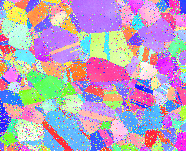 |
 |
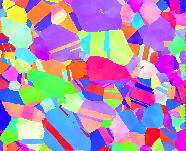 |
Example of Too Much Replacement
| Original Data | Threshold CI < 0.1 | After Running Filter | True Data |
|---|---|---|---|
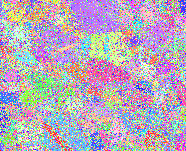 |
 |
 |
 |
Note how in the above use of the filter the grain morphology is substantially changed from the exemplar data. Except for very large grains being similar most of the fine grains and twins are NOT reproduced from the original.
Oxford/Bruker (.ctf) File¶
Oxford Instruments and Bruker CTF data files do not include a "Confidence Index" measure. There are several measures such as Mean Angular Deviation (MAD) or Bands but these values are not filled in or are defaulted to 0 (Zero) if the scan point was not indexed. By using the Error value from the data file we can get the same effect as the EDAX Confidence Index. The user would use the following input values:
| Filter Parameter | Value |
|---|---|
| Threshold Value | 0.0 |
| Operator | > |
| Selected Array | [DataContainer] / CellData / Error |
| Loop Until Gone | User dependent |
Example Oxford/Bruker Results¶
| Original Data | After Running Filter |
|---|---|
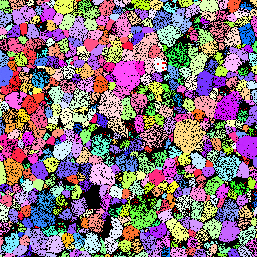 |
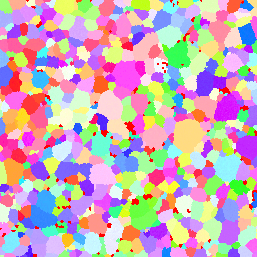 |
Note the large areas of unindexed pixels in the original image (black pixels) and how they are all filled in. The filter can act much like a generic "flood fill" image processing algorithm if used improperly.
Parameters¶
| Name | Type | Description |
|---|---|---|
| Threshold Value | Any | Sets the threshold value a Cell must have to be considered for changing |
| Comparison Operator | Int | Selects the operator to use. 0 = < (Less Than). 1 = > (Greater Than) |
| Loop Until Gone | bool | Whether to iterate until all Cells are above the minimum tolerance or just run one iteration |
Required Geometry¶
Image
Required Objects¶
| Kind | Default Name | Type | Component Dimensions | Description |
|---|---|---|---|---|
| Cell Attribute Array | N/A | Any | (1) | The DataArray to use as input into the filter. |
Created Objects¶
None
Example Pipelines¶
License & Copyright¶
Please see the description file distributed with this Plugin
DREAM.3D Mailing Lists¶
If you need more help with a Filter, please consider asking your question on the DREAM.3D Users Google group!